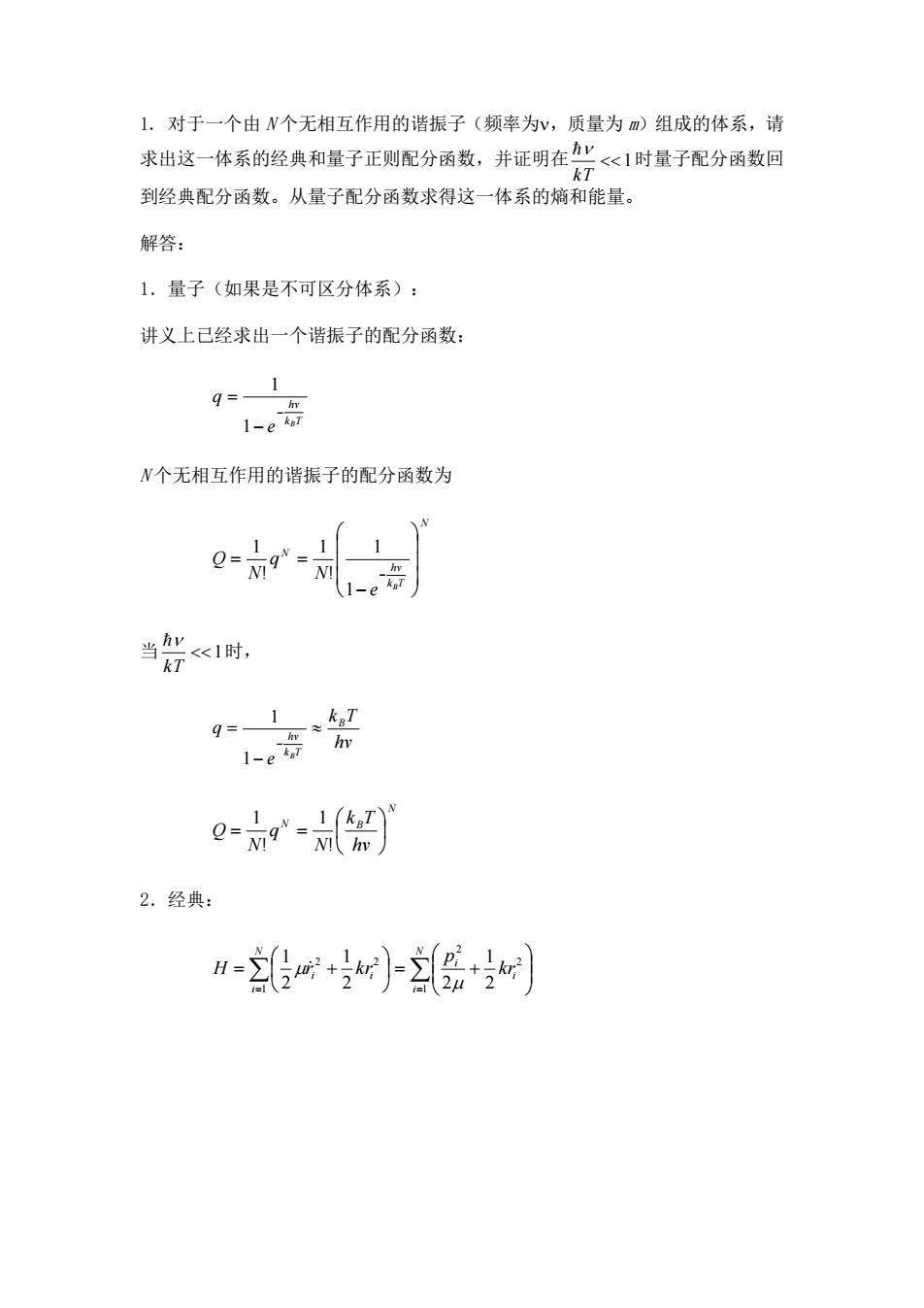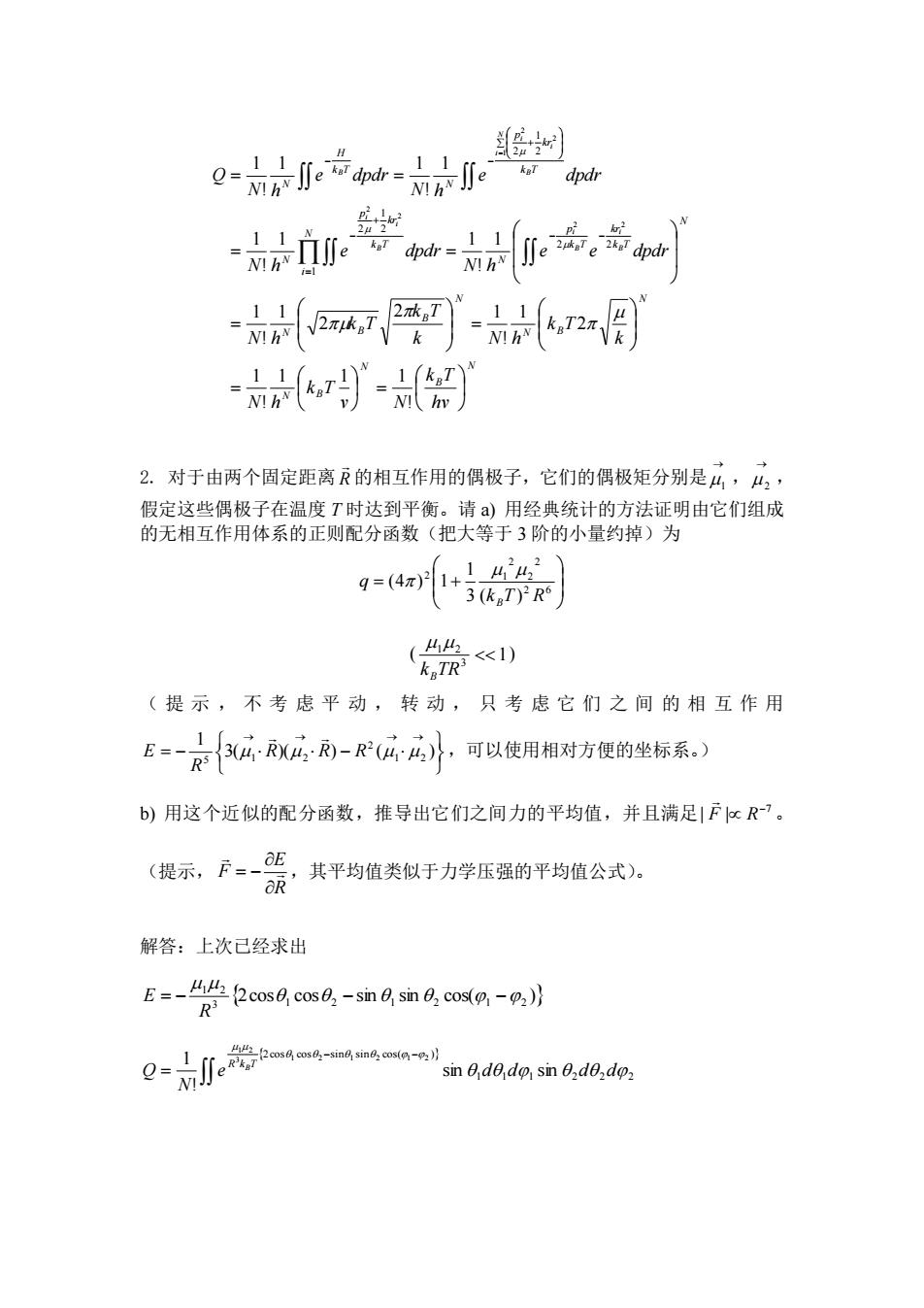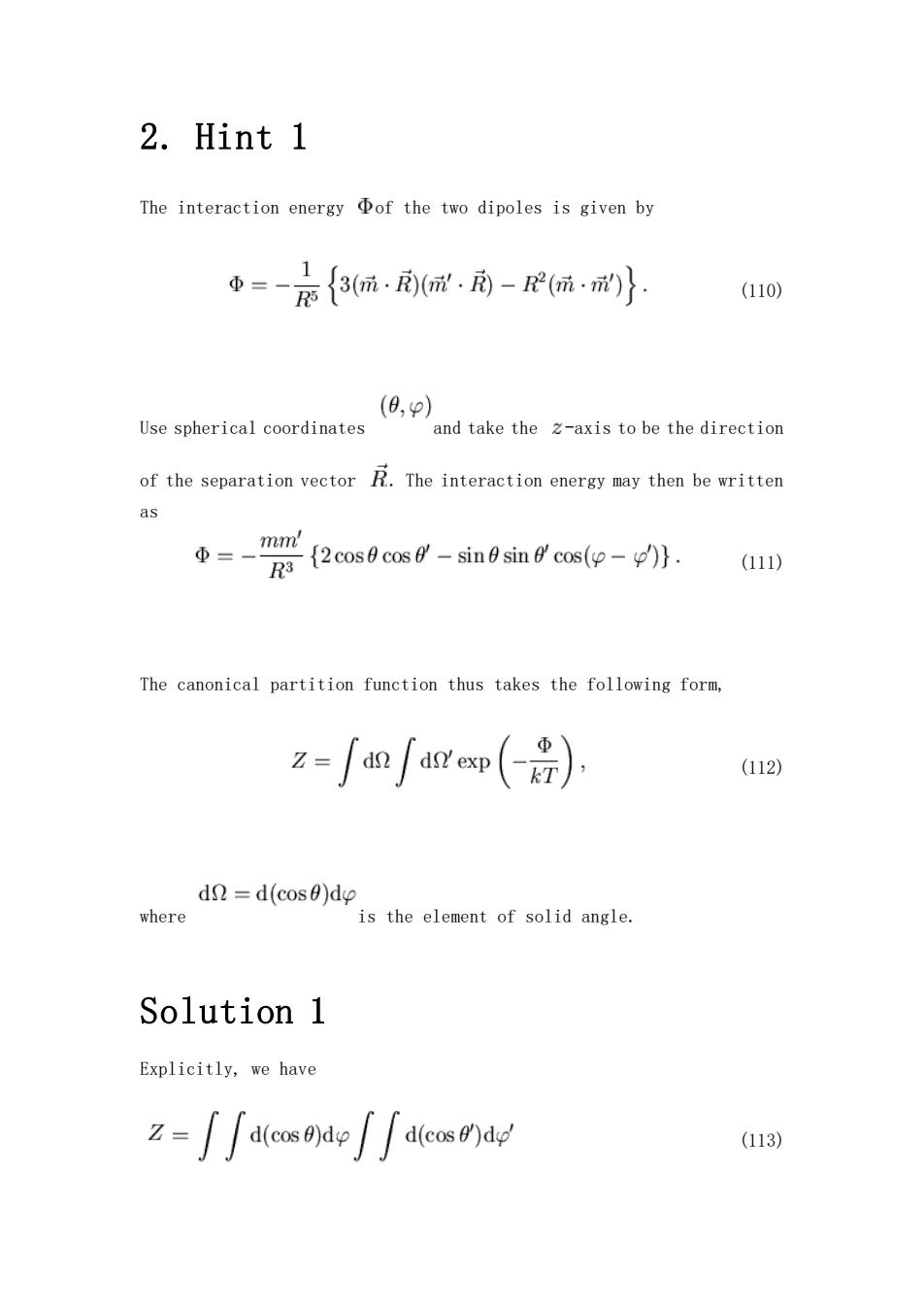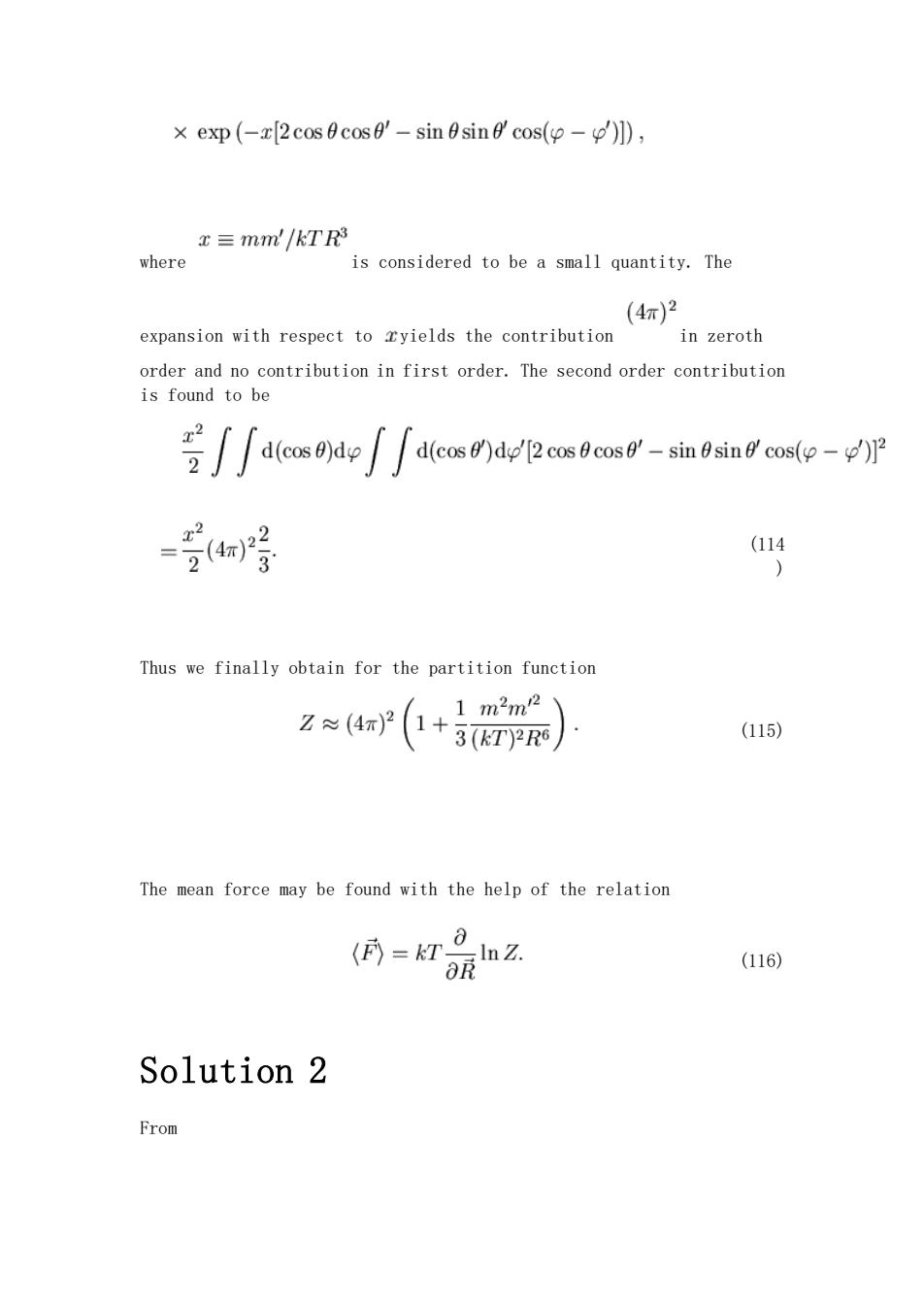
1.对于一个由W个无相互作用的谐振子(频率为v,质量为m)组成的体系,请 求出这一体系的经典和量子正则配分函数,并证明在业<1时量子配分函数回 ΓkT 到经典配分函数。从量子配分函数求得这一体系的熵和能量。 解答: 1.量子(如果是不可区分体系): 讲义上己经求出一个谐振子的配分函数: 1 g=- hy 1-e kaT N个无相互作用的谐振子的配分函数为 1-e kT 当 kT <1时, 9=1 1-e kaT 2.经典: H-+树)-28+)
1. 对于一个由 N 个无相互作用的谐振子(频率为,质量为 m)组成的体系,请 求出这一体系的经典和量子正则配分函数,并证明在 1 kT 时量子配分函数回 到经典配分函数。从量子配分函数求得这一体系的熵和能量。 解答: 1.量子(如果是不可区分体系): 讲义上已经求出一个谐振子的配分函数: k T hv B e q − − = 1 1 N 个无相互作用的谐振子的配分函数为 N k T hv N B e N q N Q − = = − 1 1 ! 1 ! 1 当 1 kT 时, hv k T e q B k T hv B − = − 1 1 N N B hv k T N q N Q = = ! 1 ! 1 2.经典: = = = + = + N i i i N i i i k r p H r k r 1 2 2 1 2 2 2 1 2 2 1 2 1

品 kgT dpdr 可n图 =) 2.对于由两个固定距离R的相互作用的偶极子,它们的偶极矩分别是4,42, 假定这些偶极子在温度T时达到平衡。请)用经典统计的方法证明由它们组成 的无相互作用体系的正则配分函数(把大等于3阶的小量约掉)为 q=(4π) 1+ 142422 3(kgT)R6 (凸凸 kaTR3 <<1) (提示,不考虑平动,转动,只考虑它们之间的相互作用 R5 34R42R-R2(442), 可以使用相对方便的坐标系。) b)用这个近似的配分函数,推导出它们之间力的平均值,并且满足|FcR-7。 (提示,F=-正, OR 其平均值类似于力学压强的平均值公式)。 解答:上次己经求出 E=2cos0,cos0-sin 0,sin 0,cos( R3 Q三fe分Ra4o4-sm40 sin e de do si edezdoz
N B N N B N N B N B N B N k T kr k T p N N i k T kr p N k T kr p N k T H N hv k T v N k T N h k k T k N h k T k T N h e e dpdr N h e dpdr N h e dpdr N h e dpdr N h Q B i B i B i i B N i i i B = = = = = = = = − − = + − + − − = ! 1 1 1 ! 1 2 1 ! 2 1 2 1 ! 1 1 ! 1 1 ! 1 1 ! 1 1 ! 1 2 2 1 2 1 2 2 1 2 2 2 2 2 1 2 2 2. 对于由两个固定距离 R 的相互作用的偶极子,它们的偶极矩分别是 → 1 , → 2 , 假定这些偶极子在温度 T 时达到平衡。请 a) 用经典统计的方法证明由它们组成 的无相互作用体系的正则配分函数(把大等于 3 阶的小量约掉)为 = + 2 6 2 2 2 2 1 3 ( ) 1 (4 ) 1 k T R q B ( 1 3 1 2 kBTR ) ( 提 示 , 不 考 虑 平 动 , 转 动 , 只 考 虑 它 们 之 间 的 相 互 作 用 = − − → → → → 3( )( ) ( ) 1 1 2 2 5 1 R 2 R R R E ,可以使用相对方便的坐标系。) b) 用这个近似的配分函数,推导出它们之间力的平均值,并且满足 7 | | − F R 。 (提示, R E F = − ,其平均值类似于力学压强的平均值公式)。 解答:上次已经求出 2cos 1 cos 2 sin 1 sin 2 cos( 1 2 ) 3 1 2 = − − − R E − − = 1 1 1 2 2 2 2cos cos sin sin cos( ) sin sin ! 1 1 2 1 2 1 2 3 1 2 e d d d d N Q R kBT

2.Hint 1 The interaction energy of the two dipoles is given by 0={36m,用m.角-㎡6mm} (110) (6,p Use spherical coordinates and take the 2-axis to be the direction of the separation vector.The interaction energy may then be written as Φ mm' R3 {2cos0 cos '-sin 0 sin 0'cos(-)}. (111) The canonical partition function thus takes the following form, z=∫n∫anam() (112) ds =d(cos0)d where is the element of solid angle. Solution 1 Explicitly,we have z=∫∫lsc的ay (113)
2. Hint 1 The interaction energy of the two dipoles is given by (110) Use spherical coordinates and take the -axis to be the direction of the separation vector . The interaction energy may then be written as (111) The canonical partition function thus takes the following form, (112) where is the element of solid angle. Solution 1 Explicitly, we have (113)

x exp(-x[2cos cos0'-sin @sin'cos(-)]), x≡mm'/kTR3 where is considered to be a small quantity.The (4r)2 expansion with respect to xyields the contribution in zeroth order and no contribution in first order.The second order contribution is found to be 5∫daos0jde厂∫deas0 d/Bow0cos9-sin0sin9 'cos-P =号a号 (114 Thus we finally obtain for the partition function Z≈(4P(1+3T西 1m2m2 (115) The mean force may be found with the help of the relation (可=kT 0 In Z. OR (116) Solution 2 From
where is considered to be a small quantity. The expansion with respect to yields the contribution in zeroth order and no contribution in first order. The second order contribution is found to be (114 ) Thus we finally obtain for the partition function (115) The mean force may be found with the help of the relation (116) Solution 2 From

z≈a✉(1+ m2m2 (KT)2R6 (117) we obtain,in the desired order, (=kT nZ 0月 m2m 3kT () m2m2 1R =-2 kT RR' (118) which implies that the magnitude of the expectation value of the force is proportional to R-7
(117) we obtain, in the desired order, (118) which implies that the magnitude of the expectation value of the force is proportional to